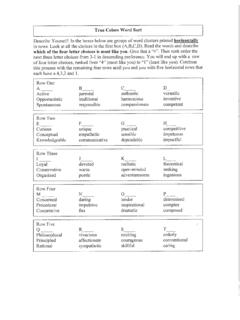Transcription of DYES , COLORS & PIGMENTS - Tarek Ismail Kakhia - …
1 0 dyes , COLORS & PIGMENTS Writing By Tarek Ismail Kakhia Copyright Tarek Kakhia . All rights reserved. Natural dye Skeins of wool colored with natural plant dyes . Contents : 1 Origins 2 Processes 3 Common dyestuffs o Reds and pinks o Oranges o Yellows o Greens o Blues o Purples o Browns o Greys and blacks o Lichen o Fungi 4 Luxury dyestuffs o Royal purple o Crimson and scarlet o The rise of formal black 5 Decline and rediscovery 6 Notes 7 References Copyright Tarek Kakhia . All rights reserved. - Introduction : Natural dyes are dyes or colorants derived from plants, invertebrates, or minerals. The majority of natural dyes are vegetable dyes from plant sources roots, berries, bark, leaves, and wood and other organic sources such as fungi and lichens. Archaeologists have found evidence of textile dyeing dating back to the Neolithic period.
2 In China, dyeing with plants, barks and insects has been traced back more than 5,000 years. The essential process of dyeing changed little over time. Typically, the dye material is put in a pot of water and then the textiles to be dyed are added to the pot, which is heated and stirred until the color is transferred. Textile fiber may be dyed before spinning (dyed in the wool), but most textiles are yarn-dyed or piece-dyed after weaving. Many natural dyes require the use of chemicals called mordants to bind the dye to the textile fibers; tannin from oak galls, salt, natural alum, vinegar, and ammonia from stale urine were used by early dyers. Many mordants, and some dyes themselves, produce strong odors, and large-scale dyeworks were often isolated in their own districts. Throughout history, people have dyed their textiles using common, locally available materials, but scarce dyestuffs that produced brilliant and permanent COLORS such as the natural invertebrate dyes Tyrian purple and crimson kermes became highly prized luxury items in the ancient and medieval world.
3 Plant-based dyes such as woad, indigo, saffron, and madder were raised commercially and were important trade goods in the economies of Asia and Europe. Across Asia and Africa, patterned fabrics were produced using resist dyeing techniques to control the absorption of color in piece-dyed cloth. dyes from the New World such as cochineal and logwood were brought to Europe by the Spanish treasure fleets, and the dyestuffs of Europe were carried by colonists to America. Copyright Tarek Kakhia . All rights reserved. The discovery of man-made synthetic dyes in the mid-19th century triggered the end of the large-scale market for natural dyes . Synthetic dyes , which could be produced in large quantities, quickly superseded natural dyes for the commercial textile production enabled by the industrial revolution, and unlike natural dyes , were suitable for the synthetic fibers that followed.
4 Artists of the Arts and Crafts Movement preferred the pure shades and subtle variability of natural dyes , which mellow with age but preserve their true COLORS , unlike early synthetic dyes , and helped ensure that the old European techniques for dyeing and printing with natural dyestuffs were preserved for use by home and craft dyers. Natural dyeing techniques are also preserved by artisans in traditional cultures around the world. 1 - Origins : COLORS in the "ruddy" range of reds, browns, and oranges are the first attested COLORS in a number of ancient textile sites ranging from the Neolithic to the Bronze Age across the Levant, Egypt, Mesopotamia and Europe, followed by evidence of blues and then yellows, with green appearing somewhat later. The earliest surviving evidence of textile dyeing was found at the large Neolithic settlement at atalh y k in southern Anatolia, where traces of red dyes , possible from ochre (iron oxide PIGMENTS from clay), were found.
5 Polychrome or multicolored fabrics seem to have been developed in the 3rd or 2nd millennium BCE . Textiles with a "red-brown warp and an ochre-yellow weft" were discovered in Egyptian pyramids of the Sixth Dynasty (2345-2180 BCE). The chemical analysis that would definitively identify the dyes used in ancient textiles has rarely been conducted, and even when a dye such as indigo blue is detected it is impossible to determine which of several indigo-bearing plants was used. Nevertheless, based on the COLORS of surviving textile fragments and the evidence of actual dyestuffs found in archaeological sites, reds, blues, and yellows from plant sources were in common use by the late Bronze Age and Iron Age. Copyright Tarek Kakhia . All rights reserved. 2 - Processes : For more details on this topic, see Glossary of dyeing terms.
6 Dyeing wool cloth , 1482 The essential process of dyeing requires soaking the material containing the dye (the dyestuff) in water, adding the textile to be dyed to the resulting solution (the dyebath), and bringing the solution to a simmer for an extended period, often measured in days or even weeks, stirring occasionally until the color has evenly transferred to the textiles. Some dyestuffs, such as indigo and lichens, will give good color when used alone; these dyes are called direct dyes or substantive dyes . The majority of plant dyes , however, also require the use of a mordant, a chemical used to "fix" the color in the textile fibers. These dyes are called adjective dyes . By using different mordants, dyers can often obtain a variety of COLORS and shades from the same dye. Fibers or cloth may be pretreated with mordants, or the mordant may be incorporated in the dyebath.
7 In traditional dyeing, the common mordants are vinegar, tannin from oak bark, sumac, or oak galls, ammonia from stale urine, and wood-ash liquor or potash (potassium carbonate) made by leaching wood ashes and evaporating the solution. We shall never know by what chances primitive man discovered that salt, vinegar from fermenting fruit, natural alum, Copyright Tarek Kakhia . All rights reserved. and stale urine helped to fix and enhance the colours of his yarns, but for many centuries these four substances were used as mordants. Salt helps to "fix" or increase "fastness" of COLORS , vinegar improves reds and purples, and the ammonia in stale urine assists in the fermentation of indigo dyes . Natural alum (aluminum sulfate) is the most common metallic salt mordant, but tin (stannous chloride), copper (cupric sulfate), iron (ferrous sulfate, called copperas) and chrome (potassium dichromate) are also used.
8 Iron mordants "sadden" COLORS , while tin and chrome mordants brighten COLORS . Additional chemicals or alterants may be applied after dying to further alter or reinforce the COLORS . A dye-works with baskets of dyestuffs skeins of dyed yarn, and heated vats for dyeing. Textiles may be dyed as raw fiber (dyed in the fleece or dyed in the wool), as spun yarn (dyed in the hank or yarn-dyed), or after weaving (piece-dyed). Mordants often leave residue in wool fiber that makes it difficult to spin, so wool was generally dyed after spinning, as yarn or woven cloth. Indigo, however, requires no mordant, and cloth manufacturers in medieval England often dyed wool in the fleece with the indigo-bearing plant woad and then dyed the cloth again after weaving to produce deep blues, browns, reds, purples, blacks, and tawnies.
9 In China, Japan, India, Pakistan, Nigeria, Gambia, and other parts of West Africa and southeast Asia, patterned silk and cotton fabrics were produced using resist dyeing techniques in which the cloth is printed or stenciled with starch or wax, or tied in various ways to prevent even penetration of the dye when the Copyright Tarek Kakhia . All rights reserved. cloth is piece-dyed. Chinese ladao is dated to the 10th century; other traditional techniques include tie-dye, batik, R ketsuzome, katazome, bandhani and leheria. The mordants used in dyeing and many dyestuffs themselves give off strong and unpleasant odors, and the actual process of dyeing requires a good supply of fresh water, storage areas for bulky plant materials, vats which can be kept heated ( often for days or weeks ), and airy spaces to dry the dyed textiles. Ancient large-scale dye-works tend to be located on the outskirts of populated areas, on windy promontories.
10 3 - Common dyestuffs : The Hunt of the Unicorn Tapestry, dyed with weld (yellow), madder (red), and woad (blue). 3 1 - Reds and pinks : A variety of plants produce red dyes , including a number of lichens, henna, alkanet or dyer's bugloss (Alkanna tinctoria), asafoetida and madder. Madder (rubia tinctoria) and related plants of the Rubia family are native to many temperate zones around the world, and have been used as a source of good red dye (rose madder) since prehistory. Madder has been identified on linen in the tomb of Tutankhamun, and Pliny the Elder records madder growing near Rome.[18] Madder was a dye of commercial importance in Europe, being cultivated in Holland and France to dye the red coats of military uniforms until the market collapsed following the development of synthetic Copyright Tarek Kakhia .











